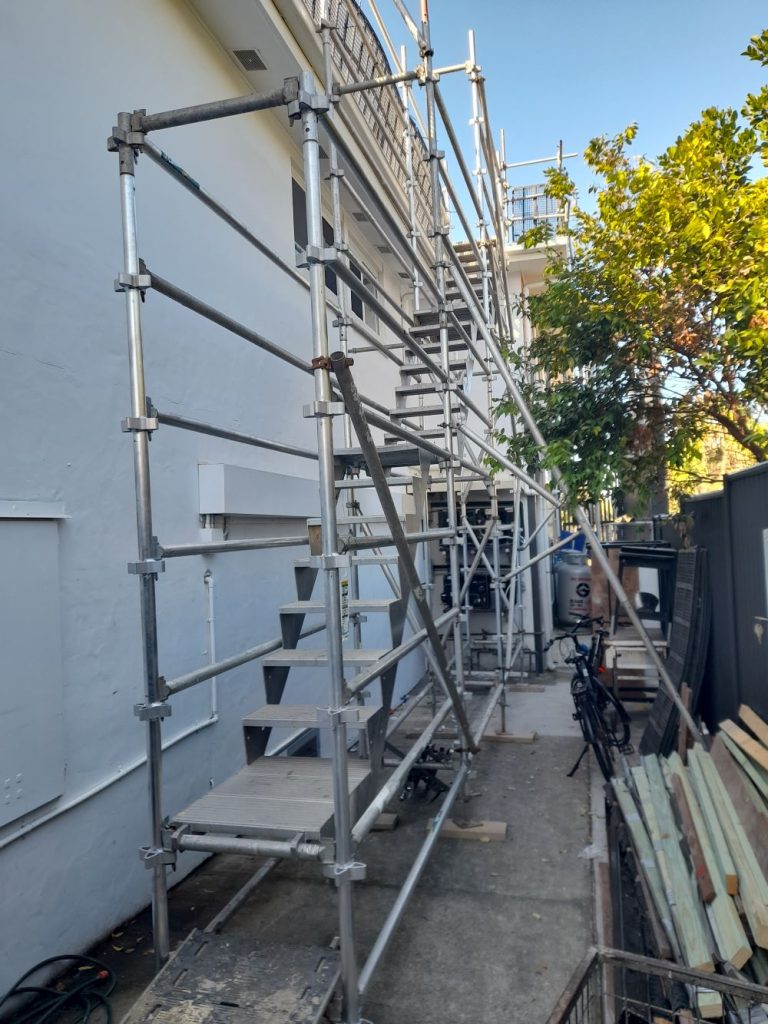If you have ever worked on or around scaffolding, you might have questioned the safety and practicality of placing a ladder atop it to access elevated areas. While this approach may seem like a convenient solution, there are critical safety considerations that need careful evaluation before proceeding. Understanding the associated risks and the relevant regulations concerning this practice is vital for ensuring the safety of yourself and everyone else in the workspace.
Although it may appear straightforward, using a ladder on scaffolding is EXCEEDINGLY hazardous. The addition of ANY extraneous items to a stable scaffolding structure can create serious dangers. The risks associated with this practice are substantial and should not be overlooked or underestimated. It is essential to prioritise safety over convenience in any construction environment to prevent accidents and ensure a secure working atmosphere.
This article delves into the various reasons why placing a ladder on scaffolding is inadvisable, highlighting potential hazards whilst discussing safer alternatives that should be seriously considered instead.

Comprehending the Safety Risks Associated with Ladder Use on Scaffolding
The unequivocal answer is NO; using a ladder on scaffolding is NOT safe.
The utilisation of a ladder on scaffolding introduces substantial dangers that can jeopardise the safety of the entire setup. The primary purpose of scaffolding is to provide a secure and stable working platform that meets stringent load-bearing specifications. When a ladder or any additional equipment is placed on this structure, it can destabilise the entire system, thereby increasing the risk of accidents, falls, and serious injuries. Consequently, while it may seem like a clever shortcut to access a higher area, the potential hazards far outweigh any perceived benefits.
Also Read: What NOT to Do When Using Scaffolding for Safety
Recognising the Dangers Linked to Ladder Use on Scaffolding
Having established that using a ladder on scaffolding is unsafe, let’s delve deeper into the specific dangers associated with this practice:
1. Instability of the Scaffolding Structure Poses a Major Threat
Scaffolding is meticulously designed as a safe and robust working platform; however, the introduction of a ladder can significantly disrupt this balance. Ladders are specifically intended to be positioned on solid ground rather than atop another structure. When a ladder is placed on scaffolding, it can destabilise the entire setup, considerably increasing the risk of falls, slips, or even complete scaffold failure. This precarious situation poses a serious danger not only to the user but also to everyone in the vicinity who may be affected by a potential mishap.
2. Heightened Fall Risk Due to Increased Elevation Levels
When working on scaffolding, you are already elevated above the ground. Adding a ladder can further increase this elevation, thereby amplifying the risk of falling. The precariousness of using a ladder on scaffolding can create dangerous situations, particularly if the ladder shifts, slips, or fails to maintain its stability. The potential for severe injuries escalates dramatically with higher falls, making this practice extremely risky and ill-advised.
Also Read: Who Is Responsible for Scaffold Hire and Safety?
3. Improper Ladder Angle Heightens the Risk of Accidents
Ladders are designed to be used at specific angles to ensure safety during operation. Placing a ladder haphazardly on top of scaffolding prevents achieving the correct angle necessary for stability. An improperly positioned ladder is susceptible to slipping or sliding, especially when placed on a surface that lacks solidity and support. Furthermore, scaffolding does not provide the same level of stability as a solid ground surface, making it challenging to secure the ladder at the appropriate angle, thus increasing the likelihood of accidents and injury.
4. Lack of Secure Attachment Creates Serious Hazards for Users
When utilising a ladder on scaffolding, it often results in insufficient securing of the ladder itself. Most scaffolding setups are not designed to accommodate ladders, meaning there is generally no reliable way to attach them securely. Although the ladder may appear stable initially, any movement, vibrations, or slips can quickly lead to the ladder falling or tipping over, presenting a serious risk not only to the user but also to those nearby who might be affected by an unexpected accident.
5. Non-Compliance with OSHA Safety Regulations Can Have Serious Consequences
If you are working on a construction site, adherence to safety regulations is often mandated. The Occupational Safety and Health Administration (OSHA) enforces strict guidelines regarding the safe use of scaffolding and ladders. Improperly using a ladder on scaffolding can lead to violations of OSHA standards (such as 1926.1053 for ladders and 1926.451 for scaffolds). Such non-compliance can result in legal repercussions, fines, penalties, or even project shutdowns, making it essential to follow safety guidelines diligently to avoid serious consequences.
6. Risks of Certification Nullification Due to Improper Methods
Every scaffolding installation undergoes a rigorous certification process to ensure that professionals have deemed it safe for use. Modifying that setup by adding a ladder compromises its certification status. In the event of an incident, you may find yourself without coverage regarding work health and safety regulations. Without valid certification, you assume significant risk, which is an unacceptable gamble that could lead to dire consequences for both the individual and the overall project.
Exploring Safer Alternatives for Accessing Elevated Areas
Now that we have thoroughly examined the reasons against using a ladder on scaffolding, let’s explore safer alternatives for achieving your desired height without compromising safety or breaching regulations:
Utilising Built-In Scaffold Access Solutions for Enhanced Safety
Most scaffolding installations come equipped with built-in access features, such as ladders or stairways. These access points are specifically designed to ensure safety while navigating up and down the scaffolding. If your scaffolding includes these built-in access options, it is crucial to take full advantage of them! They are engineered to work seamlessly with the scaffolding system, significantly enhancing overall security and minimising the likelihood of accidents or injuries occurring during use.

Considering Work Platforms or Extensions for Safer Access to Heights
Another viable alternative is to use a work platform or an extension. These solutions are designed specifically to provide a stable surface for working while offering safe access to higher levels. They represent a more secure option than attempting to balance a ladder on scaffolding. Work platforms are robust and certified for use with scaffolding, ensuring your safety while facilitating the efficient and effective completion of tasks at elevated heights, thereby reducing the risk of accidents and injuries.
Final Insights on the Use of Ladders with Scaffolding
So, can you safely place a ladder on scaffolding?
The definitive answer is no! Utilising a ladder on scaffolding can lead to structural instability, increased fall risk, and violations of crucial safety regulations. The potential consequences simply do not justify the associated risks. Instead, make use of built-in scaffold access methods or opt for safer alternatives, such as work platforms. Always prioritise safety; the last thing you want is to jeopardise your well-being or that of others for the sake of convenience. Adhering to proper guidelines will ensure you remain safe and compliant on the job.
The Article: Ladder Safety on Scaffolding: What You Need to Know first appeared on https://writebuff.com
The Article Ladder Safety Tips for Scaffolding You Must Know Was Found On https://limitsofstrategy.com

